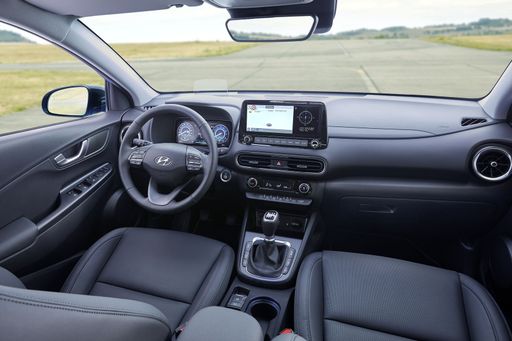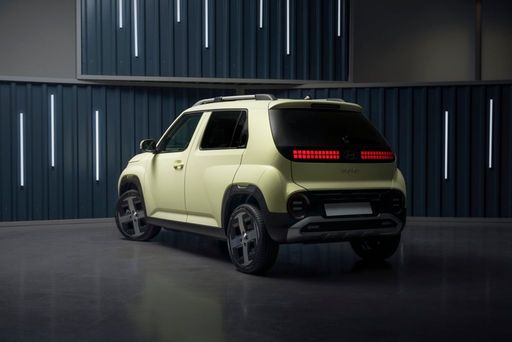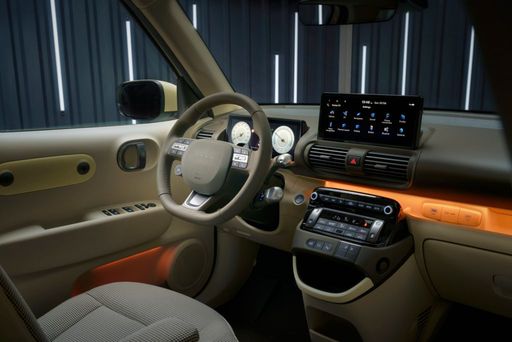Hyundai Kona VS Hyundai Inster – Specs, Efficiency & Price Comparison
Which model is the better choice – the Hyundai Kona or the Hyundai Inster? We compare performance (218 HP vs 115 HP), boot capacity (466 L vs 280 L), efficiency (14.60 kWh4.50 L vs 14.30 kWh), and of course, the price (23100 £ vs 20500 £).
Find out now which car fits your needs better!
The Hyundai Kona (SUV) is powered by a Petrol, Full Hybrid or Electric engine and comes with a Manuel or Automatic transmission. In comparison, the Hyundai Inster (SUV) features a Electric engine and a Automatic gearbox.
When it comes to boot capacity, the Hyundai Kona offers 466 L, while the Hyundai Inster provides 280 L – depending on what matters most to you. If you’re looking for more power, you’ll need to decide whether the 218 HP of the Hyundai Kona or the 115 HP of the Hyundai Inster suits your needs better.
There are also differences in efficiency: 14.60 kWh4.50 L vs 14.30 kWh. In terms of price, the Hyundai Kona starts at 23100 £, while the Hyundai Inster is available from 20500 £.
Compare all the key specs now and find out which model fits your lifestyle best!
The Hyundai Kona and Hyundai Ioniq 5 represent two distinct approaches to modern driving experiences, with the Kona offering a sporty and compact SUV feel while the Ioniq 5 embraces a spacious electric design. Both vehicles showcase Hyundai's commitment to innovation and style, but the Kona's versatility and agile handling cater to urban drivers, while the Ioniq 5's impressive range and advanced tech features appeal to eco-conscious consumers. Ultimately, the choice between these two models boils down to personal preferences in performance, design, and sustainability.
Hyundai Kona
The Hyundai Kona blends a bold design with a versatile interior, making it a standout choice in the compact SUV market. Its crisp handling and responsive steering provide an engaging driving experience, whether in the city or on the open road. The vehicle also offers a range of features designed to enhance comfort and connectivity, ensuring a pleasurable journey for both driver and passengers.
details @ hyundai.news
@ hyundai.news
 @ hyundai.news
@ hyundai.news
 @ hyundai.news
@ hyundai.news
 @ hyundai.news
@ hyundai.news
Hyundai Inster
The Inster has quickly captured the attention of automotive enthusiasts with its striking design and dynamic performance. This model seamlessly blends advanced technology with comfort, making it an ideal choice for both daily commutes and adventurous road trips. With its spacious interior and innovative features, the Inster promises an exhilarating driving experience that doesn’t compromise on practicality.
details @ hyundai.news
@ hyundai.news
 @ hyundai.news
@ hyundai.news
 @ hyundai.news
@ hyundai.news
Introduction: Comparing the Hyundai Kona and Hyundai Inster
The automotive landscape is continually evolving, and Hyundai is at the forefront with two standout models: the Hyundai Kona and the Hyundai Inster. With distinct characteristics and technical innovations, these SUVs cater to diverse driver preferences and needs. This comparative analysis will explore their standout features, engine performance, efficiency, and overall aesthetics to help you decide which model fits your automotive desires best.
Engine Performance and Powertrain
The Hyundai Kona offers a variety of engine types, including petrol, full hybrid, and electric variants. With options ranging from 100 HP to a robust 218 HP, the Kona impresses with flexibility. It offers both front-wheel and all-wheel drive configurations, complemented by options for manual and dual-clutch automatic transmissions. Acceleration is particularly notable in the Kona, with higher trims achieving 0-100 km/h in as little as 7.8 seconds.
In contrast, the Hyundai Inster focuses on an all-electric powertrain. While it has a smaller range of engine output, with 97 to 115 HP, it provides a pleasant driving experience, particularly for urban commuting. The Inster features an automatic transmission with a reduction gearbox, delivering smooth and efficient acceleration. The 0-100 km/h times range around 10.6 seconds, making it less sprightly compared to the Kona but still competitive for an electric SUV.
Efficiency and Consumption
When it comes to fuel economy, the Hyundai Kona offers impressive petrol and hybrid options, with consumption figures ranging from 5.7 L/100 km to 6.7 L/100 km in petrol models. Its electric variants shine with energy consumption of as low as 14.6 kWh/100 km, giving an electric range of up to 514 km.
On the other hand, the Hyundai Inster, being fully electric, has energy consumption figures that are slightly higher at around 14.3 to 15.1 kWh/100 km, with a range of 327 to 370 km. This positions the Inster as a suitable choice for city dwellers or those with shorter commutes, while the Kona caters to a broader spectrum of driving needs.
Design and Interior Features
In terms of design, the Hyundai Kona presents a more aggressive SUV profile with bold lines and a dynamic presence on the road. Its dimensions (Length: 4350-4385 mm, Width: 1825 mm, and Height: 1580-1585 mm) combine convenience with substantial trunk capacity of 466 liters, making it appealing for families or those needing extra cargo space.
Meanwhile, the Hyundai Inster adopts a more compact design with dimensions of 3825-3845 mm in length and 1610 mm in width. While offering less trunk capacity (280 liters), it retains a stylish, modern appearance that resonates well in urban settings. The Inster accommodates four passengers, compared to the Kona’s five, which may factor into larger families' decision-making.
Technology and Innovations
Hyundai has infused both models with advanced technology and features. The Kona is equipped with the latest in infotainment systems and driver assistance technologies across all trims. Innovations such as adaptive cruise control, lane-keeping assist, and a high-resolution display for seamless navigation enhance the driving experience.
The Inster, being a more recent addition to Hyundai's lineup, is designed with a focus on sustainability and modernity. It incorporates cutting-edge electric vehicle technology along with connectivity features that cater to the tech-savvy driver. The CO2 efficiency class of A signifies its eco-friendly approach, appealing to environmentally conscious consumers.
Conclusion: Which SUV Wins?
Ultimately, the choice between the Hyundai Kona and Hyundai Inster hinges on personal priorities. The Kona is an ideal choice for those seeking versatility in engine options, excellent range, and spaciousness. Its dynamic performance and family-friendly design make it a go-to SUV. Conversely, the Inster is a solid pick for drivers prioritizing electric mobility and urban efficiency. Its compact design and forward-thinking technology showcase Hyundai's commitment to sustainable driving.
Both models reflect Hyundai's dedication to innovation and quality. Whether embracing the gasoline-driven enthusiasm of the Kona or stepping into the future with the electric Inster, your next adventure is sure to be supported by these impressive SUVs.

|

|
|
|
|
Costs and Consumption |
|
|---|---|
|
Price
23100 - 41600 £
|
Price
20500 - 25800 £
|
|
Consumption L/100km
4.5 - 6.9 L
|
Consumption L/100km
-
|
|
Consumption kWh/100km
14.6 - 16.8 kWh
|
Consumption kWh/100km
14.3 - 15.1 kWh
|
|
Electric Range
377 - 514 km
|
Electric Range
327 - 370 km
|
|
Battery Capacity
1.3 - 65.4 kWh
|
Battery Capacity
42 - 49 kWh
|
|
co2
0 - 157 g/km
|
co2
0 g/km
|
|
Fuel tank capacity
38 - 47 L
|
Fuel tank capacity
-
|
Dimensions and Body |
|
|---|---|
|
Body Type
SUV
|
Body Type
SUV
|
|
Seats
5
|
Seats
4
|
|
Doors
5
|
Doors
5
|
|
Curb weight
1370 - 1773 kg
|
Curb weight
1380 - 1433 kg
|
|
Trunk capacity
466 L
|
Trunk capacity
238 - 280 L
|
|
Length
4350 - 4385 mm
|
Length
3825 - 3845 mm
|
|
Width
1825 mm
|
Width
1610 mm
|
|
Height
1580 - 1585 mm
|
Height
1575 - 1610 mm
|
|
Payload
420 - 490 kg
|
Payload
317 - 357 kg
|
Engine and Performance |
|
|---|---|
|
Engine Type
Petrol, Full Hybrid, Electric
|
Engine Type
Electric
|
|
Transmission
Manuel, Automatic
|
Transmission
Automatic
|
|
Transmission Detail
Schaltgetriebe, Automat. Schaltgetriebe (Doppelkupplung)
|
Transmission Detail
-
|
|
Drive Type
Front-Wheel Drive, All-Wheel Drive
|
Drive Type
Front-Wheel Drive
|
|
Power HP
100 - 218 HP
|
Power HP
97 - 115 HP
|
|
Acceleration 0-100km/h
7.8 - 13.3 s
|
Acceleration 0-100km/h
10.6 - 11.7 s
|
|
Max Speed
162 - 208 km/h
|
Max Speed
140 - 150 km/h
|
|
Torque
200 - 265 Nm
|
Torque
147 Nm
|
|
Number of Cylinders
3 - 4
|
Number of Cylinders
-
|
|
Power kW
74 - 160 kW
|
Power kW
71 - 85 kW
|
|
Engine capacity
998 - 1598 cm3
|
Engine capacity
-
|
General |
|
|---|---|
|
Model Year
2024
|
Model Year
2025
|
|
CO2 Efficiency Class
D, C, E, F, A
|
CO2 Efficiency Class
A
|
|
Brand
Hyundai
|
Brand
Hyundai
|
Hyundai Kona
The Hyundai Kona: A Comprehensive Overview
The Hyundai Kona has established itself as a standout in the compact SUV segment, blending innovation with performance and style. As the automotive world moves towards more sustainable and efficient options, the Kona offers a variety of powertrains, from traditional petrol engines to full hybrids and all-electric models.
Powertrain Options and Performance
The Hyundai Kona's powertrain choices cater to a wide range of preferences. For petrol enthusiasts, the Kona offers a 1.0L T-GDI engine, delivering 100 PS, and a more robust 1.6L T-GDI variant with up to 170 PS. Those looking for efficiency without sacrificing power can consider the full hybrid model, offering 129 PS and an impressive consumption of 4.5 L/100km.
For a greener option, the all-electric Kona provides a compelling case. With battery capacities of up to 65.4 kWh, the electric Kona offers power outputs of 156 to 218 PS, and efficiencies as low as 14.6 kWh/100km, enabling an electric range of up to 513 km.
Technical Specifications and Innovations
Built on a robust platform, the Kona delivers versatility and reliability. With a choice between manual or dual-clutch automatic gearboxes, along with options for front-wheel or all-wheel drive, the Kona ensures a tailored driving experience. The handling is enhanced by the car's lightweight construction, balancing a 1370 to 1773 kg curb weight with dynamic performance.
The Kona's design doesn't compromise cargo space for style; it offers a generous 466 L boot capacity. With a relatively compact body, measuring 4350 to 4385 mm in length, the Kona easily navigates urban environments while still commanding a strong road presence with its 1825 mm width.
Efficiency and Eco-Friendliness
Hyundai is committed to reducing emissions, as evidenced by the Kona's CO2 efficiency ratings, which range from class A for electric models to class D for some higher-performance petrol variants. The focus on reducing environmental impact without sacrificing driving pleasure is notable throughout the Kona range.
Costing and Value
The Hyundai Kona offers commendable value for money. Pricing starts at €26,400 and reaches up to €50,690, depending on the chosen configuration. The monthly running costs range from €956 to €1090, with a cost per kilometre of 38.3 to 43.6 cents, making it a competitive option in its class.
Conclusion: Modern, Efficient, and Versatile
The Hyundai Kona stands as a testament to Hyundai's commitment to innovation, efficiency, and practicality. Whether you are inclined towards a traditional combustion engine, a hybrid for a balance of power and efficiency, or a full electric model for maximum eco-friendliness, the Kona provides a tailored solution for each unique driver preference.
Hyundai Inster
The automotive landscape continues to evolve, and at the forefront of this transformation is the Hyundai Inster, a dynamic model set to impress electric vehicle enthusiasts. As a compact SUV, the Inster embodies a blend of innovative technology, user-friendly features, and an eco-conscious design, making it a contender in the burgeoning electric vehicle market.
Powertrain and Performance
The Hyundai Inster is powered by an efficient electric drivetrain, offering two main battery options: a 42 kWh and a 49 kWh version. These options translate to power outputs of 97 HP and 115 HP, respectively, allowing drivers to choose based on their performance needs. The Inster accelerates from 0 to 100 km/h in 11.7 seconds for the 42 kWh variant, while the more powerful 49 kWh model reaches the same speed in an impressive 10.6 seconds, showcasing Hyundai's commitment to delivering engaging performance.
Range and Efficiency
One of the standout features of the Inster is its electric range. The 42 kWh model provides a range of 327 km, while the 49 kWh variants extend the range to 360 km and 370 km. This remarkable efficiency is complemented by consumption figures of 14.3 kWh/100 km for the 42 kWh variant and 14.9 kWh/100 km for the 49 kWh options. These figures ensure that the Inster is not only suited for city driving but also capable of handling longer journeys with ease.
Dynamic Design and Comfortable Interior
Aesthetically, the Hyundai Inster boasts a sleek and modern look, featuring a compact SUV profile that is both sporty and practical. The dimensions, measuring between 3825 mm and 3845 mm in length, with a width of 1610 mm and heights ranging from 1575 mm to 1610 mm, contribute to its spacious and comfortable cabin. The interior accommodates up to four passengers, making it an ideal choice for small families or couples.
Innovative Features
The Inster incorporates advanced technology geared towards enhancing the driving experience. Its automatic transmission, utilizing a reduction gearbox, ensures seamless gear shifts. Additionally, drivers will appreciate the array of smart features designed for convenience and connectivity, including advanced infotainment systems and driver assistance technologies.
Sustainability Credentials
Hyundai is dedicated to sustainability, and the Inster is a testament to this philosophy. With a carbon footprint of zero emissions, the Inster falls into the A CO2 efficiency class, making it a responsible choice for eco-conscious consumers. The absence of traditional emissions positions the Inster not only as an economical option but also as a proactive step towards reducing our environmental impact.
Conclusion
The Hyundai Inster stands out as a versatile and innovative solution in the electric vehicle segment. With a balanced approach to performance, efficiency, and sustainability, it caters to the modern driver’s needs and reflects the automotive industry's shift towards electrification. The future looks bright for the Inster, as Hyundai continues to pave the way for greener driving experiences.
The prices and data displayed are estimates based on German list prices and may vary by country. This information is not legally binding.
